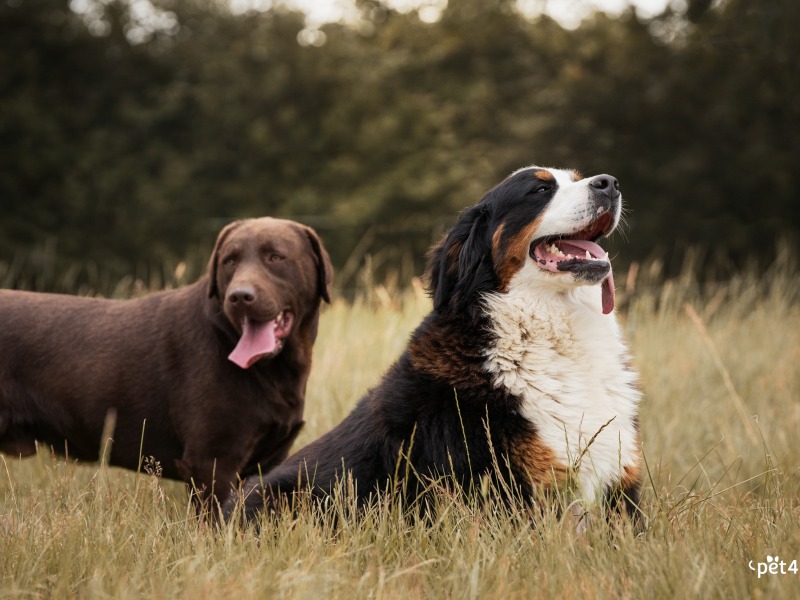Labrador-retriever
Autres noms : Labrador
Discover the Labrador Retriever, an affectionate, intelligent, and versatile dog, perfect for families. Learn all about its friendly temperament, activity needs, and suitable training.
Awareness of acquiring an animal
Adopting or breeding a dog is a responsibility that must be carefully considered. Dogs are loyal companions that require time, attention, and constant care. Whether for leisure, passion, or professional breeding, it is crucial to understand the specific needs of each breed. Provide them with a loving and stimulating environment, and avoid any impulsive acquisition that could harm their well-being. Be a vigilant and committed owner for a happy and healthy companion.
To learn more about animal welfare, we invite you to consult our FAQ by clicking the button below:
Origins and history
The Labrador Retriever traces its origins to Newfoundland, Canada, in the early 19th century. This dog was developed from retriever-type dogs and other local breeds, primarily to assist fishermen in their daily tasks, such as retrieving fishing lines and fish. Over time, these dogs became known for their friendly nature, intelligence, and great ability to work in the water.
By the mid-19th century, enthusiasts began importing these dogs to Britain, where they were selected for their skills as hunting dogs. British breeders emphasized their gentle temperament and aptitude for retrieving game, making the breed popular among hunters. This selection also enhanced physical characteristics, including a sturdy body and water-resistant coat.
Today, Labrador Retrievers are among the most popular breeds in the world, valued not only for their working skills but also for their affectionate and sociable nature. They are often used as companion dogs, in assistance roles, and for various recreational activities, showcasing a versatility that continues to make them a favored breed.
Physical characteristics
The Labrador Retriever is a medium to large-sized dog, with a well-proportioned and sturdy body. Generally, males measure between 56 and 61 cm in height at the shoulder, while females are slightly shorter, ranging from 51 to 56 cm. Their weight varies from 25 to 36 kg, with males typically being heavier.
Its head is broad with a well-developed skull. The eyes are of medium size, express keen intelligence, and are often brown or hazel in color. The ears are droopy and of medium size, hanging close to the cheeks. The tail, or "otter tail," is thick at the base and tapers towards the tip, giving it a muscular appearance.
The coat is dense, short, and water-resistant, allowing the dog to thrive in an aquatic environment. Coat colors range from black, chocolate, to yellow. This coat, combined with its athletic build, gives the Labrador Retriever a look that is both elegant and powerful, perfectly suited to its skills as a retriever.
Character
The Labrador Retriever is known for its friendly and sociable temperament. This dog is generally very dedicated to its family, constantly seeking affection and companionship from humans. Its sociable nature makes it particularly well-suited for family life, where it gets along well with children and other animals.
One of the most striking traits of this breed is its intelligence. Its ability to learn quickly makes it ideal for various roles, whether as a working, assistance, or companion dog. Thanks to this intelligence, it excels in obedience, which facilitates education and training.
Furthermore, the Labrador Retriever is an active and energetic dog. It needs regular exercise to stay healthy. Walks, games, and water activities are ideal ways to channel its boundless energy. This physical activity helps it remain balanced and happy.
Finally, loyalty is an essential trait of this breed. The Labrador Retriever forms deep attachments to its owners, offering gentle and affectionate protection. This loyalty, combined with its cheerful temperament, makes it an invaluable companion.
Life expectancy
The life expectancy of a Labrador Retriever is typically between 10 and 12 years. However, this duration can vary depending on several factors such as genetics, diet, exercise, and medical care. Properly raising a Labrador and providing it with a healthy lifestyle can help maximize its life expectancy.
Predisposition to certain diseases can also influence longevity. This type of dog is particularly sensitive to conditions like hip dysplasia, eye problems, and obesity. Regular veterinary check-ups, along with a balanced diet, play a crucial role in preventing these diseases.
Exercise is also a key factor in the overall health of a Labrador. Regular physical activities not only help maintain a healthy weight but also promote mental well-being. An active and engaged Labrador generally has a better quality of life, contributing to a longer lifespan.
In summary, while a life expectancy of 10 to 12 years is the norm, lifestyle choices and care can make all the difference.
Exercise and activity needs
The Labrador Retriever is a very energetic and active dog breed that requires a significant amount of daily exercise to maintain its physical and mental health. Generally, a minimum of 1 to 2 hours of activity per day is recommended. These dogs love to run, play, and explore, which makes them very adaptable to various types of walks or outdoor activities.
Interactive games, such as fetch or frisbee, are particularly enjoyed by this breed. These activities not only fulfill their need for physical exercise but also stimulate their intelligence and natural retrieving instinct. Varied environments, such as parks or beaches, provide ideal opportunities to unleash their energy.
In addition to physical exercise, mental activities, such as obedience training or learning new tricks, are essential to prevent boredom. A healthy and happy Labrador is one that has a balance between physical activity and mental stimulation, contributing to its overall well-being.
Recommended diet
Labrador Retrievers are energetic and active dogs, which requires a suitable diet to support their health and vitality. Their diet should be rich in high-quality protein to promote muscle development and maintain a healthy weight. A source of animal protein, such as chicken, beef, or fish, is essential to meet their nutritional needs.
It is also important to include healthy fats in their diet, as these provide a concentrated source of energy. Omega-3 and omega-6 fatty acids are beneficial for the skin and coat, contributing to their shine.
Carbohydrates should be present in moderation, coming from sources like sweet potatoes or brown rice, which are easy to digest and provide lasting energy. Vegetables such as carrots or green beans can also be added for fiber and micronutrients.
Finally, it is crucial to monitor portions and avoid overweight, as Labradors are predisposed to obesity. Consulting with a veterinarian can help establish a balanced diet tailored to the dog's age, weight, and activity level.
Training and obedience
Training and educating Labrador Retrievers requires a specific approach, considering their friendly temperament and high intelligence. These dogs are known for their sociable and affectionate nature, which generally makes them receptive to instructions. Early socialization is essential; it's important to expose the dog to various environments, people, and other animals from a young age. This helps to develop their confidence and alleviate timid or aggressive behaviors.
Training should be done positively and gradually. Using rewards, such as treats and praise, is very effective in motivating these dogs. They learn quickly, but a positive approach is crucial to maintain their enthusiasm. Short and frequent training sessions help keep their attention, as their natural curiosity can easily distract them.
Finally, it is important to remember that regular physical activity is essential. Labradors require a lot of exercise, not only for their physical well-being but also for their mental balance. Walks, playtime, and interactive training sessions are key elements for a happy and well-balanced Labrador.
Behavior with children
The Labrador Retriever is renowned for being one of the dog breeds best suited for family life, particularly due to its gentle and friendly temperament. These dogs are generally very sociable and enjoy interacting with children. They tend to be protective and caring, quickly forming strong bonds with younger family members.
Their playful nature makes them excellent playmates. Labrador Retrievers are often full of energy and love participating in outdoor activities, such as ball games or walks. Their enthusiasm can inspire a sense of play and adventure in children, thus enhancing family interactions. However, it is important to teach children to interact respectfully with them, avoiding sudden movements that might startle the dog.
Despite their patience, Labrador Retrievers should be socialized from a young age. Proper training helps instill appropriate behaviors in both the dogs and the children. Thanks to their affectionate nature and tolerance, these dogs can become true allies in the emotional and social development of children. Guiding these interactions helps build a trusting relationship, which is beneficial for everyone.
Compatibility with Other Animals
The Labrador Retriever is generally recognized for its sociable and friendly nature, making it a beloved companion in households that include other pets. Its sweet and playful personality fosters positive interactions with other dogs. This breed often has a balanced temperament, which helps establish a healthy hierarchy and avoid potential conflicts.
Regarding other animals, such as cats, Labradors can also coexist harmoniously. While some Labradors may have a more pronounced prey instinct, early socialization and proper training can mitigate these behaviors. Owners should ensure gradual introductions to facilitate a smooth adjustment.
Additionally, this dog has a great capacity for adaptation, allowing it to adjust easily to various environments. Its curious nature and tendency to want to interact make it an excellent companion for other animals. In summary, with thoughtful socialization and an appropriate setting, the Labrador Retriever typically integrates well into a multi-pet household.
Grooming needs
The Labrador Retriever is a breed of dog with short, dense fur, which makes grooming easier. However, it requires regular maintenance to maintain the health of its skin and coat. Weekly brushing is recommended to remove dead hair and prevent matting. During shedding periods, typically in spring and autumn, it may be necessary to brush more frequently, up to several times a week.
In addition to grooming, it is important to monitor the ears of the Labrador due to their structure, which can promote moisture. Regular cleaning with a suitable product helps prevent infections. The teeth should also be maintained through regular brushing and chew toys to ensure good dental hygiene.
Finally, one should not forget the importance of nail care. They should be trimmed regularly, especially if the dog does not spend much time on rough surfaces. Overall, regular maintenance is essential to ensure the health and well-being of the Labrador Retriever.
Health
The health of Labrador Retrievers is influenced by several genetic and environmental factors. This breed is predisposed to certain hereditary conditions, notably hip and elbow dysplasia. These joint problems can cause pain and reduced mobility, making regular veterinary check-ups essential. Early screening and rigorous selection of breeders can help reduce the prevalence of these disorders.
Moreover, Labradors are also prone to eye problems, such as hereditary cataracts. These conditions can affect their vision and quality of life. Regular ophthalmological examinations are recommended to detect such issues.
Obesity represents another major challenge for this breed. Due to their voracious appetite, Labradors can quickly gain weight and develop associated problems, such as diabetes or heart disorders. A balanced diet and daily physical activity are crucial for maintaining their health.
Finally, proper socialization and regular veterinary care contribute to ensuring the overall well-being of these dogs, which are known for their friendly and affectionate temperament. Caring for Labradors therefore requires constant vigilance regarding the various aspects of their health.
Environment and habitat
The Labrador Retriever is a dog breed appreciated for its friendly temperament and versatility. These dogs thrive in environments where they can regularly interact with humans and other animals. An active family setting is ideal, as they enjoy participating in various activities, including play and walks. Their sociable nature generally means they adapt well to indoor living, provided they get enough exercise.
In terms of habitat, a secure outdoor space is desirable. Labradors love to swim, run, and explore, so it is essential to provide them with opportunities to expend their energy. A fenced garden is a great asset, as it allows them to play safely.
Labradors also require mental stimulation, which can come in the form of interactive games, training activities, and obedience skills. An enriching environment helps prevent destructive behaviors associated with boredom. In summary, a setting that offers interaction, exercise, and stimulation is crucial for ensuring the well-being of this dynamic breed.
Name ideas
Choosing a name for a Labrador Retriever is a crucial step that reflects not only your affection for your dog but also its character and distinctive traits. A good name should be easy to pronounce and remember, both for the owner and the dog. It is advisable to opt for short names, typically one or two syllables, as these are easily recognizable by the animal.
Think about your Labrador Retriever's personality. Some Labradors are particularly active and joyful, while others may be calmer and more thoughtful. A name that reflects their behavior or physical characteristics can strengthen your bond. Also, consider the color of their coat: Labradors can be black, yellow, or chocolate, and these hues can inspire specific names.
Here are some name suggestions that might suit a Labrador Retriever: Max, Bella, Charlie, Luna, Rocky, Daisy, Buddy, Zoe, Cooper, Maya, Oscar, Nala, Simba, Finn, and Ruby. These simple and original names can help establish a strong connection with your loyal companion while being easy to use in everyday life.
Average purchase price
The price of a Labrador Retriever can vary depending on several factors. Generally, prices for a puppy of this breed range from 800 to 2,000 euros. The acquisition costs largely depend on the breeder's reputation, the dog's lineage, and the geographical location of the breeding.
Established breeders, who can offer guarantees regarding the health and well-being of the animals, tend to charge higher prices. These breeders often invest in health testing to avoid genetic issues and ensure good temperament. Conversely, lower prices may be associated with less scrupulous breeders or online sales, where the health and welfare of the animals are not always guaranteed.
In addition to the initial acquisition cost, it is essential to consider the long-term expenses associated with pet ownership. This includes food, veterinary care, vaccinations, and necessary accessories. These costs can quickly add up and should be taken into account before adopting a puppy.
Expenses
Owning a Labrador Retriever involves significant monthly expenses, which can vary based on several factors. On average, it is reasonable to budget around 300 to 500 euros per month. These costs encompass several essential aspects related to the health and well-being of the animal.
First of all, food constitutes a considerable part of the budget. A Labrador requires quality food suited to its size and activity level, which can cost between 50 and 100 euros per month. Additionally, it is crucial to include treats and possibly dietary supplements.
Next, veterinary expenses are unavoidable. Vaccinations, annual check-ups, and parasite prevention can range from 20 to 50 euros per month when considering costs spread over the year. It is wise not to overlook pet health insurance, which can cost between 20 and 70 euros per month depending on the chosen coverage.
In addition, there are expenses for accessories, such as toys, grooming supplies, and equipment, often estimated at around 20 to 40 euros monthly. Costs for pet sitting, walking, or training may also be added, especially if the owner works during the day.
In summary, a total budget of between 300 and 500 euros per month is a realistic estimate for the well-being of a Labrador Retriever, taking into account food, veterinary care, accessories, and other ancillary expenses.
Destination and usage
The Labrador Retriever is one of the most popular breeds as a pet. Its friendly nature and balanced temperament make it an excellent companion for families. These dogs are particularly suited for homes with children, as they are often gentle and protective. Their sociability also makes them compatible with other animals, facilitating life in a community.
In terms of activities, the Labrador Retriever excels in outdoor outings and interactive games. They love playing fetch or engaging in other retrieving games, allowing them to expend their energy while strengthening their bonds with their owners. Daily walks are essential to maintain their physical and mental well-being, and these dogs generally enjoy these moments of companionship.
Furthermore, their intelligence and willingness to please make the Labrador Retriever a quick learner. This facilitates training and the establishment of various routines at home. Because of this trait, they are often involved in activities such as agility or hiking, thereby reinforcing their role as a loyal and active companion.
Legislation and regulation
The legislation and regulations regarding Labrador Retrievers vary significantly from country to country. In many countries, this breed is widely accepted and considered an ideal family dog due to its friendly nature and gentle temperament. Thus, there are generally no specific restrictions related to this breed, allowing owners to enjoy their presence in households.
However, some countries enforce laws regarding dogs in general, which include requirements for vaccination, sterilization, and training. These regulations aim to ensure public safety and animal welfare. In urban contexts, restrictions may apply concerning the size or behavior of dogs, but this does not specifically target Labradors.
In other regions, stricter laws may be implemented for dogs considered potentially dangerous, although Labradors are generally not included in these categories. Owners of this breed should familiarize themselves with local legislation and ensure they comply with established care and behavior standards to guarantee harmonious coexistence with the community.
Official recognition
The official recognition of Labradors varies by country, but the breed is widely accepted internationally. In many European countries, as well as in the United States, Labradors are recognized by major canine organizations, which establish detailed breed standards. These standards specify aspects such as temperament, physical appearance, and behavioral traits that make this breed highly valued.
In France, for example, the Société Centrale Canine has validated the breed criteria, facilitating its registration in the studbook. Similarly, in the United Kingdom, the Kennel Club places great importance on promoting these dogs as pets and working animals, especially in rescue and assistance missions.
In other regions, such as Asia, the popularity of Labradors has led to official recognition. Local dog clubs have also formed, promoting specific events for Labradors, which reflects their growing status in these countries. However, the regulation and organization of the breed can vary, requiring efforts to ensure their well-being and proper selection.
Pedigrees
To obtain a pedigree for the Labrador Retriever breed, there are several organizations and dog clubs that play a crucial role in the registration and certification of bloodlines. One of the main players is the Société Centrale Canine (SCC) in France, which is the official body responsible for the registration of purebred dogs. Breeders and owners of Labradors can register their dog with this organization to obtain an official pedigree.
In other countries, there are national clubs specifically dedicated to Labradors. For example, in the United Kingdom, the Labrador Retriever Club (LRC) provides a registration system that certifies bloodlines and promotes the breed. In the United States, the American Kennel Club (AKC) serves a similar function by allowing the registration of purebred dogs, including Labradors.
Finally, regional clubs or those specific to certain provinces may also offer registration and evaluation services for dogs. These clubs are often linked with national organizations and help preserve the breed standards. Labrador owners can thus ensure that their pet belongs to a quality bloodline with a recognized pedigree.
Prohibitions
The bans on certain dog breeds vary significantly from country to country. In most European countries, there are no specific bans on Labrador Retrievers, which are generally considered to be friendly and sociable dogs. Legislation often focuses on breeds perceived as dangerous, leaving Labradors outside of these classifications.
However, some municipalities may enforce strict regulations related to dog ownership in general, including vaccination requirements, leashes, and muzzles in public spaces. In countries like the United States, the situation is similar, with restrictions varying from state to state. Labradors are generally welcomed in most areas, provided their owners adhere to local laws regarding dog ownership.
It is also important to note that concerns related to dog safety can influence public perceptions and regulations. Although Labradors are often viewed as ideal pets, isolated incidents can lead to debates about owner responsibility. In summary, while there are no specific bans targeting this breed, responsibility and adherence to local laws remain crucial for all dog owners.
Breeders of Labrador-retriever
Want to see more breeders of Labrador-retriever?
Check out the page of our directory listing all breeders of Labrador-retrieverClassified Ads of Labrador-retriever
Want to see more ads of Labrador-retriever?
Check out the page listing all the ads of Labrador-retrieverBreed clubs of labrador-retriever
No of labrador-retriever breed clubs are currently registered on Preeders.
If you would like to highlight your breed club, sign up for free now and be the first to appear on this page.






